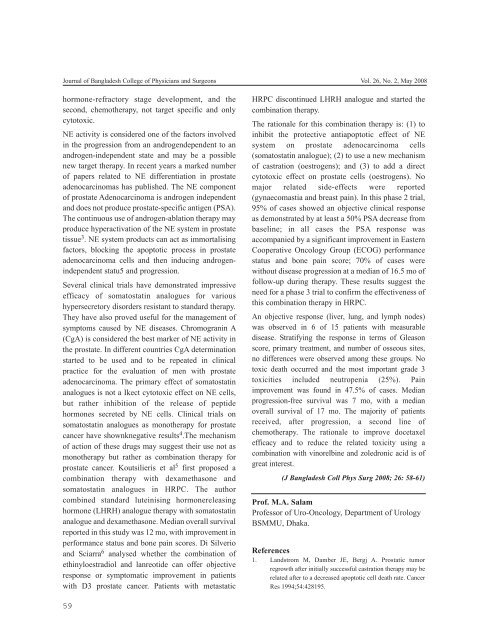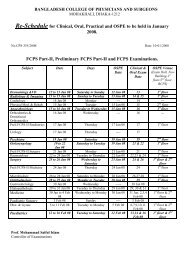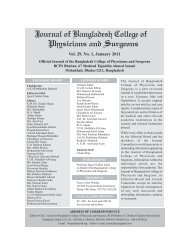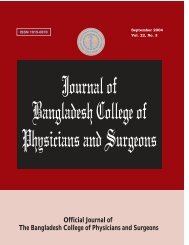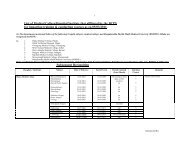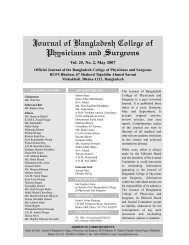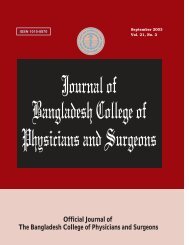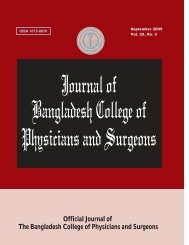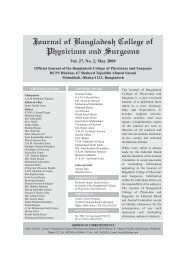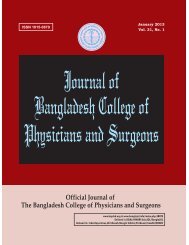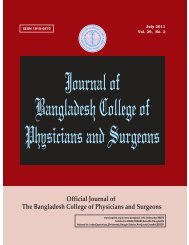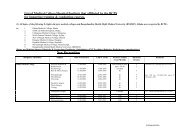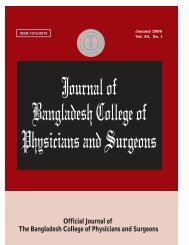May 2008 - bcps
May 2008 - bcps
May 2008 - bcps
Create successful ePaper yourself
Turn your PDF publications into a flip-book with our unique Google optimized e-Paper software.
Journal of Bangladesh College of Physicians and Surgeons Vol. 26, No. 2, <strong>May</strong> <strong>2008</strong>hormone-refractory stage development, and thesecond, chemotherapy, not target specific and onlycytotoxic.NE activity is considered one of the factors involvedin the progression from an androgendependent to anandrogen-independent state and may be a possiblenew target therapy. In recent years a marked numberof papers related to NE differentiation in prostateadenocarcinomas has published. The NE componentof prostate Adenocarcinoma is androgen independentand does not produce prostate-specific antigen (PSA).The continuous use of androgen-ablation therapy mayproduce hyperactivation of the NE system in prostatetissue 3 . NE system products can act as immortalisingfactors, blocking the apoptotic process in prostateadenocarcinoma cells and then inducing androgenindependentstatu5 and progression.Several clinical trials have demonstrated impressiveefficacy of somatostatin analogues for varioushypersecretory disorders resistant to standard therapy.They have also proved useful for the management ofsymptoms caused by NE diseases. Chromogranin A(CgA) is considered the best marker of NE activity inthe prostate. In different countries CgA determinationstarted to be used and to be repeated in clinicalpractice for the evaluation of men with prostateadenocarcinoma. The primary effect of somatostatinanalogues is not a Ikect cytotoxic effect on NE cells,but rather inhibition of the release of peptidehormones secreted by NE cells. Clinical trials onsomatostatin analogues as monotherapy for prostatecancer have shownknegative results 4 .The mechanismof action of these drugs may suggest their use not asmonotherapy but rather as combination therapy forprostate cancer. Koutsilieris et al 5 first proposed acombination therapy with dexamethasone andsomatostatin analogues in HRPC. The authorcombined standard luteinising hormonereleasinghormone (LHRH) analogue therapy with somatostatinanalogue and dexamethasone. Median overall survivalreported in this study was 12 mo, with improvement inperformance status and bone pain scores. Di Silverioand Sciarra 6 analysed whether the combination ofethinyloestradiol and lanreotide can offer objectiveresponse or symptomatic improvement in patientswith D3 prostate cancer. Patients with metastaticHRPC discontinued LHRH analogue and started thecombination therapy.The rationale for this combination therapy is: (1) toinhibit the protective antiapoptotic effect of NEsystem on prostate adenocarcinoma cells(somatostatin analogue); (2) to use a new mechanismof castration (oestrogens); and (3) to add a directcytotoxic effect on prostate cells (oestrogens). Nomajor related side-effects were reported(gynaecomastia and breast pain). In this phase 2 trial,95% of cases showed an objective clinical responseas demonstrated by at least a 50% PSA decrease frombaseline; in all cases the PSA response wasaccompanied by a significant improvement in EasternCooperative Oncology Group (ECOG) performancestatus and bone pain score; 70% of cases werewithout disease progression at a median of 16.5 mo offollow-up during therapy. These results suggest theneed for a phase 3 trial to confirm the effectiveness ofthis combination therapy in HRPC.An objective response (liver, lung, and lymph nodes)was observed in 6 of 15 patients with measurabledisease. Stratifying the response in terms of Gleasonscore, primary treatment, and number of osseous sites,no differences were observed among these groups. Notoxic death occurred and the most important grade 3toxicities included neutropenia (25%). Painimprovement was found in 47.5% of cases. Medianprogression-free survival was 7 mo, with a medianoverall survival of 17 mo. The majority of patientsreceived, after progression, a second line ofchemotherapy. The rationale to improve docetaxelefficacy and to reduce the related toxicity using acombination with vinorelbine and zoledronic acid is ofgreat interest.(J Bangladesh Coll Phys Surg <strong>2008</strong>; 26: 58-61)Prof. M.A. SalamProfessor of Uro-Oncology, Department of UrologyBSMMU, Dhaka.References1. Landstrom M, Damber JE, Bergj A. Prostatic tumorregrowth after initially successful castration therapy may berelated after to a decreased apoptotic cell death rate. CancerRes 1994;54:428195.59


